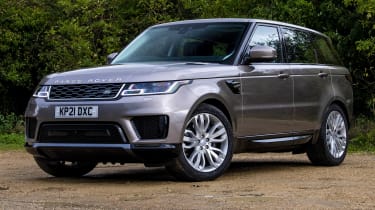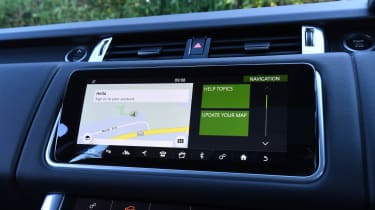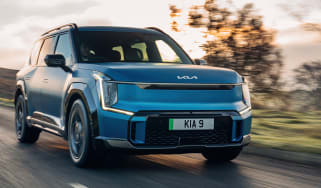Range Rover Sport PHEV (2018-2022) review
The Range Rover Sport PHEV has many of the strengths of the larger Range Rover PHEV, but is a fair bit cheaper to buy, if a little less practical
Pros
- 25-mile electric range
- Works well in town
- Good to drive
Cons
- Not as economical as some rivals
- Batteries reduce practicality
- No seven-seat version
| Car type | Electric range | Fuel economy | CO2 emissions |
|---|---|---|---|
| Plug-in hybrid | 25 miles | 75-88mpg | 75-83g/km |
Range Rover has long been known for making luxury SUVs and capable off-roaders, but less so for more economical hybrid vehicles. The latest Range Rover Sport has been electrified using similar technology to the larger Range Rover. This plug-in hybrid (PHEV) model is known as the P400e, and it mixes practicality with technology and surprisingly low running costs. The Sport is more affordable than its larger sibling, the Range Rover PHEV, but is still a high-end luxury car.
The luxury plug-in hybrid SUV market has really taken off of late, so there are many rivals to consider, including the BMW X5, Mercedes GLE and Volvo XC90, all of which work similarly. The first downside of the P400e, however, is its below-average range of 25 miles on the electric motor alone, but fuel economy of over 70mpg is possible if you plug in often.
A particularly attractive aspect of the P400e Range Rover Sport is its lower company-car tax rate, given the plug-in hybrid’s lower CO2 emissions than non-hybrid models. Not only does the hybrid powertrain keep costs down, but when you’re silently running around town using the electric motor, the P400e manages to feel even more luxurious and relaxing.
As with most plug-in hybrids, the Range Rover Sport PHEV might not be the best choice for long trips, as the added weight of the batteries that aren’t being used for those sorts of distances affects fuel economy, so the 2.0-litre petrol engine returns less than 30mpg when working alone. It’s best to think about what your plans for the car are before you buy, but if you’re looking for a plug-in SUV you probably already know that.
The battery in the P400e takes seven-and-a-half hours to charge completely using a domestic electricity supply, but a home wallbox will reduce that time significantly. Make sure to buy the optional Type 2 charging cable if you want to use a public rapid charger, which will charge the car in under three hours.
When the 114bhp electric motor and 297bhp 2.0-litre turbocharged petrol engine work together, the car will accelerate from 0-62mph in just 6.7 seconds, which is remarkably quick for such a big, heavy SUV. The Range Rover Sport is good to drive, thanks to its punchy performance and surprisingly good handling, but the Porsche Cayenne is more fun. On top of that, the Sport is also very adept off tarmac. In fact, the instant torque and keen responses of its electric motors are a distinct help when trying to negotiate tricky terrain.
It’s true that the PHEV looks a little more expensive than some of its most direct rivals, but it does come very well equipped. So well equipped, in fact, that there’s no real need to buy anything more expensive than the 'basic' HSE Silver version, which comes with LED headlamps, automatic lights and wipers, 21-inch alloy wheels, dual-zone climate control and sat nav.
Beyond that, should you fancy it, HSE Dynamic trim gives you different alloy wheels and plusher seats with heating front and rear. There’s also HSE Dynamic Black, with an appropriately dark theme to the added trim. On top of that, the range-topping Autobiography adds a sliding panoramic sunroof, heated and cooled seats and three-zone climate control.
Whichever trim you go for, the Range Rover Sport PHEV has a wonderfully plush interior. This was much improved by a 2018 facelift, when Land Rover introduced a new twin-screen infotainment system inspired by the unit in the smaller Range Rover Velar. True, it’s not the easiest system to use, but give it time and you can master it.

What you'll certainly appreciate is that there’s room for four – and five at a pinch – in luxurious comfort inside, so this makes a fine family car. However, there are a few drawbacks to be aware of. For a start, the PHEV's boot is smaller than the regular Sport's, and there’s no seven-seat option. In both cases, that’s because the batteries have to be housed under the boot floor, which is higher as a result.
The plug-in Range Rover Sport has a fine balance of abilities on and off-road, as well as all the class and quality you'd expect of a Range Rover. Throw in the good standard equipment, spacious interior, strong safety credentials and improving reliability, and this is a car that’s certainly worth a look if you want a premium hybrid SUV. For a more detailed look at the Range Rover Sport PHEV, read on for the rest of our in-depth review...




